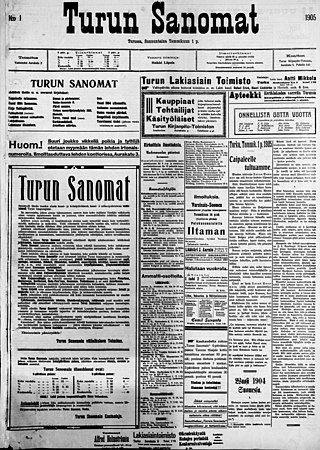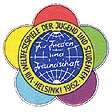Related Research Articles
Helsingin Sanomat, abbreviated HS and colloquially known as Hesari, is the largest subscription newspaper in Finland and the Nordic countries, owned by Sanoma. Except after certain holidays, it is published daily. Its name derives from that of the Finnish capital, Helsinki, where it is published. It is considered a newspaper of record for Finland.

Ilta-Sanomat is one of Finland's two prominent tabloid size evening newspapers and the second largest paper in the country. Its counterpart and biggest rival is Iltalehti.
Alma Media Oyj is a Finnish media and digital service business company. Its best known products are Iltalehti, Kauppalehti, Talouselämä, Monster.fi and Etuovi.com.

Aamulehti is a Finnish-language daily newspaper published in Tampere, Finland. Established in 1881 by Finnish patriots in Tampere, the newspaper aimed to bolster the Finnish language and people's identity during Russia's reign over Finland. Throughout the Cold War, Aamulehti was accused by the Soviet Union of spreading US propaganda, leading to protests from the Soviet Embassy in Helsinki. In the 1980s, the newspaper's parent company acquired and later closed down Uusi Suomi. In 2014, Aamulehti transitioned from broadsheet to tabloid format.

Hufvudstadsbladet is the highest-circulation Swedish-language newspaper in Finland. Its headquarters is located in Helsinki, the capital of Finland. The name of the newspaper translates approximately into "Journal of the Capital", hufvudstad being the 19th-century Swedish spelling for capital. The newspaper is informally also called Husis or Höblan.

Turun Sanomat is the leading regional newspaper of the region of Southwest Finland. It is published in the region's capital, Turku and the third most widely read morning newspaper in Finland after Helsingin Sanomat and Aamulehti.
Iltalehti is a tabloid newspaper published in Helsinki, Finland.

Finland and the United States currently have good relations. The United States was one of the first countries to recognize Finland after it declared independence in 1917, and officially established diplomatic relations in 1920. Due to World War II and Soviet pressure, relations were suspended between 1942 and 1945 before being raised to embassy level in 1954. Finland has been of strategic importance to the United States due to its position bordering the Soviet Union and later Russia, and after the end of the Cold War in 1991 Finland's shift to the West has led to warmer relations. There is significant trade activity, including military procurement, between the two countries. The United States supported Finlanď's NATO membership during Finland's accession into NATO, which was finalized on 4 April 2023.
Kauppalehti is a commerce-oriented newspaper published in Helsinki, Finland. The paper has been in circulation since 1898.

Kansan Uutiset is a Finnish language weekly newspaper published in Helsinki, Finland. It is the party organ of the Left Alliance.

Keskisuomalainen is a daily Finnish language newspaper published in Jyväskylä, serving central Finland. Its parent company Keskisuomalainen Oyj owns nearly 80 newspapers.

Etelä-Suomen Sanomat is a Finnish daily newspaper published in Lahti, Finland. It is the leading paper in its metropolitan area.
Kainuun Sanomat is a Finnish morning newspaper published in Kainuu, also in some parts in the eastern part of former Oulu (province).
Länsi-Suomi is a morning broadsheet newspaper published in Finland, based in Rauma.
Suomenmaa is a Finnish language party newspaper published four days a week from Tuesday to Friday in Oulu, Finland.

Seppo Erkki Sakari Heikinheimo was a Finnish musicologist, music journalist, writer and translator.
Tyrvään Sanomat is a Finnish language newspaper published in Sastamala, Finland. It is the oldest local newspaper in the country.

The 8th World Festival of Youth and Students (WFYS) was held in 1962 in Helsinki, capital city of Finland.

In Finland, the far right was strongest in 1920–1940 when the Academic Karelia Society, Lapua Movement, Patriotic People's Movement (IKL) and Export Peace operated in the country and had hundreds of thousands of members. In addition to these dominant far-right and fascist organizations, smaller Nazi parties operated as well.

Viikkosanomat was an illustrated weekly news magazine in Finland which was published between 1922 and 1975. During its lifetime it was one of the most read magazines in the country.
References
- ↑ Heikki Hellman; Maarit Jaakkola; Raimo Salokangas (2017). "From Culture Wars to Combat Games". In Nete Nørgaard Kristensen; Kristina Riegert (eds.). Cultural Journalism in the Nordic Countries. Stockholm: Nordicom. p. 51. ISBN 978-91-87957-58-1.
- 1 2 3 4 5 6 Antti Ainamo (May 2006). "Between West and East: A Social History of Business Journalism in Cold War Finland". Human Relations. 59 (5): 611–636. doi:10.1177/0018726706066550. hdl: 10227/397 .
- ↑ Fabio Ferrarini (2020). "'Mediterraneo baltico': Italian Fascist propaganda in Finland (1933–9)". Modern Italy. 25 (4): 398. doi:10.1017/mit.2020.51.
- ↑ Esko Salminen (1998). "The Struggle Over Freedom of Speech in the North The Finnish Press Gave Obeisance to Moscow, but did not Succumb to the Kremlin's Propaganda Programme during the Cold War Years 1968-1991". Scandinavian Journal of History. 23 (3–4): 244. doi:10.1080/03468759850115972.
- ↑ Raimo Salokangas. "From Political to National, Regional and Local" (PDF). Cirebon. Archived from the original (Book chapter) on 14 December 2014. Retrieved 14 December 2014.
- ↑ Vilma Laoma; et al. (2011). "Corporate Reputation and the News Media in Finland". In Craig Carroll (ed.). Corporate Reputation and the News Media: Agenda-setting Within Business News Coverage in Developed, Emerging, and Frontier Markets (PDF). Routledge. ISBN 978-1-135-25244-1.
- ↑ Peter Kjær; Tore Slaatta (2007). Mediating Business: The Expansion of Business Journalism. Copenhagen Business School Press DK. p. 57. ISBN 978-87-630-0199-1.
- ↑ Jens Cavallin (1993). Media Concentration and Media Ownership in the Nordic Countries. Nordic Council of Ministers. p. 2. ISBN 978-92-9120-205-8.
- ↑ Yleisradio: Uusi Suomi herää henkiin internetissä 25 May 2007; Markkinointi ja mainonta 25 May 2007, Helsingin Sanomat 26 Nay 2007 and Ilta-Sanomat 25 May 2007
- ↑ Kari Karppinen; Hannu Nieminen; Anna-Laura Markkanen (2014). "High Professional Ethos in a Small, Concentrated Media Market" (PDF). Blogipalvelut. Retrieved 29 December 2014.